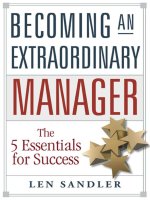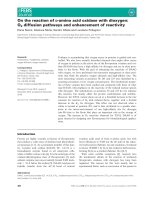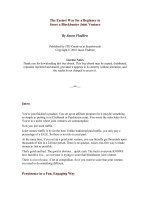Leading the Starbucks Way: 5 Principles for Connecting with Your Customers, Your Products and Your People
Bạn đang xem bản rút gọn của tài liệu. Xem và tải ngay bản đầy đủ của tài liệu tại đây (3.78 MB, 354 trang )
PRAISE FOR
LEADING THE STARBUCKS WAY
“Starbucks Coffee and Tea Company began just a few blocks from
my business, the Pike Place Fish Market. Joseph Michelli helped
me tell the story of how we create engaging and powerful experi-
ences at Pike Place Fish. He has also been trusted to work with
and share business principles used at companies like Starbucks,
The Ritz-Carlton Hotel Company, and Zappos. In Leading the
Starbucks Way, Joseph takes an incisive look at the leadership
excellence of Starbucks. Unlike his prior book about the coffee
leader, Leading the Starbucks Way helps you leverage the con-
nection you build at the person-to-person level while expanding
your customer bond globally, through technology, and even onto
your products and goods. What are you waiting for? Buy the book,
dive-in, gain practical tools, and be transformed!”
—JOHN YOKOYAMA,
Owner of the World Famous Pike
Place Fish Market and coauthor of
When Fish Fly
“Joseph Michelli offers interesting insights into the fundamentals
involved in creating the world’s biggest coffee chain. As a busi-
nessperson, you will learn how Starbucks leaders drive success as
well as how they learn from setbacks. By reading Leading the
Starbucks Way, you will be able to bypass many business pitfalls
and streamline your pursuit of desired business objectives.”
—MARTIN LINDSTROM,
bestselling author of Buyology and
Brandwashed
“Culture is everything! This fast-moving, fascinating book gives
you countless practical ideas you can use immediately to create a
company climate of inspiration and loyalty.”
—BRIAN TRACY, author of Full
Engagement
“In Leading the Starbucks Way, Joseph Michelli shows us how a
small Seattle-based chain of coffee shops became one of the most
beloved brands on the planet. Charming, real-life examples of
true service culture blend with behind-the-scenes corporate train-
ing strategies to create a pleasant and interesting read. So grab a
cup of coffee, put your feet up, and read this book!”
—KEN BLANCHARD,
coauthor of The One Minute Man-
ager® and Leading at a Higher Level
“As a Seattleite who remembers when there was just one Star-
bucks store on the planet, I continue to be fascinated by the com-
pany’s evolutionary journey to corporate icon. Michelli identifies
the principles by which Howard Schultz and his team passionately
perform in a culture that loves, respects, and rewards suppliers,
employees, customers, shareholders, and the community.”
—ROBERT SPECTOR,
author of The Nordstrom Way and
coauthor of the forthcoming What’s
Love Got to Do with It?: Courting,
Catching, and Caring for the Ideal
Customer
“Leading the Starbucks Way provides the key success factors of a
lifestyle brand that is globally scaled, locally relevant, and
powered by the passion of the Starbucks culture.”
—JOHN TIMMERMAN, PHD,
Senior Strategist of Customer Experi-
ence and Innovation, Gallup
3/354
cept as permitted under the United States Copyright Act of 1976,
no part of this publication may be reproduced or distributed in
any form or by any means, or stored in a database or retrieval sys-
tem, without the prior written permission of the publisher.
ISBN: 978-0-07-180126-3
MHID: 0-07-180126-X
The material in this eBook also appears in the print version of this
title: ISBN: 978-0-07-180125-6, MHID: 0-07-180125-1.
E-book conversion by Codemantra
Version 2.0
All trademarks are trademarks of their respective owners. Rather
than put a trademark symbol after every occurrence of a trade-
marked name, we use names in an editorial fashion only, and to
the benefit of the trademark owner, with no intention of infringe-
ment of the trademark. Where such designations appear in this
book, they have been printed with initial caps.
McGraw-Hill Education eBooks are available at special quantity
discounts to use as premiums and sales promotions or for use in
corporate training programs. To contact a representative please
visit the Contact Us page at www.mhprofessional.com.
Starbucks® coffee, Starbucks® café, Starbucks VIA® Ready
Brew, Frappuccino® blended beverage, Seattle’s Best Coffee®
café, Seattle’s Best Coffee® coffee, Tazo® Tea, and other names
or marks in this book are trademarks of Starbucks Coffee Com-
pany. The absence of a trademark from this list or the absence of
TM, SM, or ® symbol in connection with the marks in the book
does not constitute a waiver of any intellectual property rights
that Starbucks has established in any of its trademarks.
Pike Place is a trademark of The Pike Place Market PDA, used un-
der license.
Keurig and K-Cups are trademarks of Keurig, Incorporated, used
with permission. K-Cup® packs for use in Keurig® K-Cup brew-
ing system.
TERMS OF USE
This is a copyrighted work and McGraw-Hill Education and its li-
censors reserve all rights in and to the work. Use of this work is
subject to these terms. Except as permitted under the Copyright
Act of 1976 and the right to store and retrieve one copy of the
work, you may not decompile, disassemble, reverse engineer, re-
produce, modify, create derivative works based upon, transmit,
distribute, disseminate, sell, publish or sublicense the work or any
part of it without McGraw-Hill Education’s prior consent. You
may use the work for your own noncommercial and personal use;
any other use of the work is strictly prohibited. Your right to use
the work may be terminated if you fail to comply with these
terms.
THE WORK IS PROVIDED “AS IS.” McGRAW-HILL
EDUCATION AND ITS LICENSORS MAKE NO GUARANTEES
OR WARRANTIES AS TO THE ACCURACY, ADEQUACY OR
COMPLETENESS OF OR RESULTS TO BE OBTAINED FROM
USING THE WORK, INCLUDING ANY INFORMATION THAT
CAN BE ACCESSED THROUGH THE WORK VIA HYPERLINK
OR OTHERWISE, AND EXPRESSLY DISCLAIM ANY
WARRANTY, EXPRESS OR IMPLIED, INCLUDING BUT NOT
LIMITED TO IMPLIED WARRANTIES OF MERCHANTABILITY
OR FITNESS FOR A PARTICULAR PURPOSE. McGraw-Hill
Education and its licensors do not warrant or guarantee that the
functions contained in the work will meet your requirements or
that its operation will be uninterrupted or error free. Neither
McGraw-Hill Education nor its licensors shall be liable to you or
anyone else for any inaccuracy, error or omission, regardless of
cause, in the work or for any damages resulting therefrom.
6/354
McGraw-Hill Education has no responsibility for the content of
any information accessed through the work. Under no circum-
stances shall McGraw-Hill Education and/or its licensors be liable
for any indirect, incidental, special, punitive, consequential or
similar damages that result from the use of or inability to use the
work, even if any of them has been advised of the possibility of
such damages. This limitation of liability shall apply to any claim
or cause whatsoever whether such claim or cause arises in con-
tract, tort or otherwise.
7/354
8/354
9/354
10/354
This book is dedicated to the memory of my wife,
Nora Leigh Michelli (September 7, 1961, to February 11, 2013)—
the woman with whom I shared more than half my life.
You’ve been released from your six-year battle with breast can-
cer,
and I know you heard, “Well done, good and faithful servant.”
Nora, it is your time to enjoy the Master’s happiness!
Contents
Foreword
Acknowledgments
1. The Starbucks Connection
PRINCIPLE 1
SAVOR AND ELEVATE
2. If You Don’t Have Passion for Your Product, Why Should
Your Customer?
3. From Replicable and Consistent to Magical and Unique
PRINCIPLE 2
LOVE TO BE LOVED
4. It’s a Matter of Trust and Love
5. It Must Thrive Inside to Be Experienced Outside
PRINCIPLE 3
REACH FOR COMMON GROUND
6. Assume the Universal: Serve the Unifying Truths of Humans
7. Respect, Celebrate, and Customize: Listening and Innovat-
ing to Meet Local, Regional, and Global Needs
PRINCIPLE 4
MOBILIZE THE CONNECTION
8. Growing the Connection Through Technology
9. Personal Relationships Translate: Sharing the Love from
People to Products
PRINCIPLE 5
CHERISH AND CHALLENGE YOUR LEGACY
10. Honor the Past, but Don’t Be Trapped in It
11. Taking the Long View: Building Success That Lasts
12. Forging a Real Lifestyle Connection
Bibliography
Index
13/354
Foreword
Many business leaders today face a dynamic set of challenges.
How does one choose employees who have the talents and inter-
personal qualities necessary to deliver memorable customer ex-
periences? How can leaders bring on board, train, and acculturate
team members so that they develop a passion for product excel-
lence and the skills required to become consummate service pro-
fessionals? How can technology be leveraged to strengthen, not
diminish, personal service delivery?
If you are fortunate enough to be a manager or leader in a com-
pany with a global footprint like The Ritz-Carlton Hotel Company
or Starbucks, you face the added challenges of constantly refining
your products and services to connect with changing and cultur-
ally diverse customer groups—all the while maintaining opera-
tional excellence and the loyalty of your existing customer base.
Each of Dr. Joseph Michelli’s books offers a learning laboratory
that’s rich with examples from leaders as they address the afore-
mentioned challenges and opportunities. They provide informa-
tion, insights, and analysis on how leaders seek to create a high-
performance organization that operates through the lens of hu-
manity. This book demonstrates both the setbacks and the break-
throughs that the Starbucks leadership has encountered as it has
attempted to position its products and people to deliver consist-
ent, engaging, and loyalty-enhancing experiences.
I first met Dr. Michelli approximately six years ago. At that
time, he brought his background as a customer experience profes-
sional, business consultant, and author to The Ritz-Carlton Hotel
Company and chronicled our never-ending commitment to foster
the engagement of our “Ladies and Gentlemen” and the guests
whom we are fortunate to serve at our hotels and resorts in 27
countries presently.
As president of The Ritz-Carlton Hotel Company, I believe that
a company’s culture is critical to its success. At The Ritz-Carlton,
we strive to anticipate and exceed guests’ expectations in a warm,
relaxed, and refined setting. We are constantly looking for ways to
infer and go beyond the wants, needs, and desires of our Ladies
and Gentlemen and of our guests. All of the Ladies and Gentle-
men of The Ritz-Carlton (myself included) invest in and commu-
nicate about our cultural foundation on a daily basis.
American author M. Scott Peck suggested that we should
“share our similarities, and celebrate our differences.” While The
Ritz-Carlton and Starbucks are different organizations in many
respects, Leading the Starbucks Way is a powerful and useful re-
minder that every one of us (no matter what our function or our
industry) can contribute in some way to improved product qual-
ity, enhanced service delivery, emotionally engaging experiences,
and enriched community involvement.
I wish you a fond farewell and joyful reading.
HERVE HUMLER
President and Chief Operations Officer
The Ritz-Carlton Hotel Company, L.L.C.
15/354
Acknowledgments
Physician, philosopher, and theologian Albert Schweitzer once
wrote, “At times our own light goes out and is rekindled by a
spark from another person. Each of us has cause to think with
deep gratitude of those who have lighted the flame within us.” In
the next few paragraphs, I am challenged to express the depths of
my gratitude to so many people who have blessed my life with a
willingness to kindle the flame that made this book possible.
Leading the Starbucks Way would not exist were it not for the
support of Howard Schultz and the leadership team at Starbucks.
While a list of Starbucks partners who contributed to it can be
found in the Bibliography, special recognition must be provided
to Gina Woods, director, Executive Communications, and Heidi
Peiper, program manager, Corporate Communications. Both Gina
and Heidi were involved in all strategic and tactical aspects
needed to take Leading the Starbucks Way from idea to reality.
Thanks for your patience, enthusiasm, insights, and diligence.
Lynn Stenftenagel has worked on five books with me, starting
with The Starbucks Experience. Through years of book writing,
unimaginable business success, and our share of headwinds, I can
resoundingly say that there is no one I admire and respect more
than Lynn. While we continue to grow and refine our business re-
lationship, there is no denying the transformational impact that
Lynn has had on my career and my life. When it comes to our
work, Lynn is the true “keeper of the flame.”
During that same five-book run, I have been fortunate to work
with Donya Dickerson and Lloyd Rich. Lloyd, my publishing at-
torney, is the epitome of professionalism. He is an exceptional
subject-matter expert with an amazing ability to create win/win
solutions. Donya, an executive editor at McGraw-Hill, has the
enviable ability to spark people to perform at unexpected levels.
Donya sets clear performance expectations and dives in to help
realize those objectives; but it is her unfailing encouragement,
even temperament, and resourcefulness that push people past
what they think they are capable of doing.
While this book is dedicated to Nora Michelli, I must provide
some context if the remainder of these acknowledgments is to
make sense. Nora and I met in 1987, married in 1989, and parted
in the final stage of this book’s completion. In fact, my earthly
time with Nora ended in 2013 as our children and I sat at her bed-
side while she took her final breath.
Over the course of our journey, Nora and I brought into the
world two children: Andrew and Fiona. We laughed, fought, de-
lighted, angered, prayed, and battled cancer—together. I am
happy to say that Nora knew everything about me and forgivingly
loved me anyway, and for that I am eternally grateful.
During her extended cancer fight, and upon her death, many
people have relit my life flame. Andrew and Fiona, you are my
most significant inspirations. I know your lives have been pain-
fully altered with the loss of your mom, but I pledge to be the best
parent possible to carry forward the part of her that was delighted
by and believed in your greatness and your ability to change the
world. Andrew, may your nursing career allow you to transfer
your loving spirit into acts of healing. Fiona, congratulations on
Loyola and your journey into a life of leveraging business leader-
ship to do significant good in the world.
Jim Collins talks about the people you would place on the
board of directors of your life. The following have earned that
place for me by their sage counsel, amazing depths of compassion,
leadership vision, and resolute friendship, particularly during the
challenges of late. Thank you, Rob Graf, Bob and Judy Yarmuth,
17/354
Tommy and Diane Nance, Jeff Woodell, Barry and Lori Torman,
Matt Lurz, Paul Prouty, Leanne Hadley, and Michael Pollard.
Thanks as well to those who have taught me so much about
serving others through their example. Not the least of these in-
clude Kim Blankenburg, Carolyn Churchill, and so many others at
Janus Capital Group, as well as Christie Schatz and staff members
at Sonny’s Franchise Company. Similarly, I offer gratitude and
praise for Saint Peter’s Healthcare System in New Brunswick,
New Jersey, Jackie Houston, and the special nurses of Sun-coast
Hospice.
As always, I conclude with a word of gratitude to you the read-
er. Nothing plays a greater role in sparking me to write than an
appreciation for the willingness of someone like you to take the
time to read, learn, and grow. Philosopher Eric Hoffer said, “In
times of change learners inherit the earth; while the learned find
themselves beautifully equipped to deal with a world that no
longer exists.” I extend a heartfelt thank you for allowing me to
learn and to share with you. May Leading the Starbucks Way play
a small role in helping us all move forward in this grand
adventure!
18/354
The Starbucks Connection
A couple in Switzerland make their first visit to a Star-
bucks® store and are welcomed enthusiastically. When
asked what they’d like to have prepared for them, they
both respond that they aren’t there to make a purchase.
They just want to see “what all the Starbucks fascination
is about.” They become regulars at that store.
A partner (as employees are called at Starbucks) shares
how he was “moved” while attending the funeral of a
regular customer. During the eulogy, the son of the de-
ceased expressly mentioned the significance of those
daily interactions between his father and that Starbucks
partner.
A man sits alone at lunch in his favorite Starbucks store
and tells a green apron–clad Starbucks barista (coffee
preparer) that the store is his midday refuge, noting, “At
Starbucks, you are nice to me, you remember me, and
you seem genuinely grateful that I am here.”
These actual stories exemplify a company whose leaders establish
a compelling vision and manifest behaviors that culminate not
only in product sales but in powerful, loyalty-rich human
connections. You are probably looking into the pages of this book
to essentially understand how “all this Starbucks fascination
comes about.” How do leaders at Starbucks strategically and tac-
tically steward the company’s products and people to build cus-
tomer engagement, loyalty, advocacy, and even brand love? How
do these leaders model and inspire excellence in product delivery,
the creation of moments of authentic service, an enterprise-wide
appreciation for the importance of shareholder value, and a con-
tagious demonstration of social conscience? You are probably also
interested in what Starbucks partners are doing to expand rela-
tionships beyond the café environment, how they leverage tech-
nology to enhance customer experiences, and the ways in which
they customize offerings to address local desires across the globe.
Ultimately, lessons from Starbucks leaders, managers, and front-
line partners will teach you to build connections with those you
serve to effectively enrich your business and personal life.
STARBUCKS: A LEADERSHIP
BENCHMARK
Starbucks is consistently recognized as one of the world’s most ef-
fectively led and beloved brands. For example, Entrepreneur
magazine ranks the company among the 10 “most trusted” busi-
nesses, and Fortune magazine places it among the “most ad-
mired” global brands. Before delivering an important jobs speech,
U.S. president Barack Obama placed a call to the president, chair-
man, and chief executive officer of Starbucks, Howard Schultz,
because of Howard’s leadership on job creation. Fortune
magazine has named Howard Schultz as businessperson of the
year, and other magazines have suggested that he is among the
20/354
top tier of global leaders when it comes to his impact on business
ethics. Leadership across all levels of the company has produced
more than 54 million Facebook fans, and millions more follow the
company on Twitter and Pinterest.
Most important, Starbucks leaders are responsible for substan-
tial global economic and social impact as well as considerable
workforce stewardship. Starbucks leaders guide more than
200,000 people who serve the more than 60 million weekly cus-
tomers frequenting more than 18,000 stores in more than 60
countries worldwide.
My previous book about Starbucks, The Starbucks Experience:
5 Principles for Turning Ordinary into Extraordinary, looked at
how Starbucks leaders positioned the company for meteoric
growth through much of the 1990s and early 2000s. Following
the publication of that book, Starbucks leaders faced challenges
resulting from their frenzied speed of expansion, decisions they
made to drive year-over-year sales numbers, the effects of a slid-
ing global economy, and less frequent visits from loyal customers
to Starbucks U.S. stores. In 2008, Howard Schultz, who had been
serving as the chief global strategist for Starbucks, returned to the
helm as the company’s chief executive officer. At the fiscal 2008
second-quarter earnings conference call, when Howard was ex-
plaining a 21 percent earnings decline over the prior year period,
he noted, “While our financial results are clearly being impacted
by reduced frequency to our U.S. stores, we believe that as we
continue to execute on the initiatives generated by our Trans-
formation Agenda, we will reinvigorate the Starbucks Experience
for our customers, and in doing so, deliver increased value to our
shareholders.”
Howard’s “Transformation Agenda” is detailed in his 2011 book
titled Onward: How Starbucks Fought for Its Life without Los-
ing Its Soul. At its core, Starbucks leadership crafted a transition
plan that established a forward-looking vision that enhanced the
21/354
company’s established mission. While the Starbucks mission was
“to inspire and nurture the human spirit—one person, one cup
and one neighborhood at a time,” the transformation vision set an
energizing and rallying objective, “to become an enduring, great
company with one of the most recognized and respected brands in
the world, known for inspiring and nurturing the human spirit.”
Tactically, Starbucks leaders identified “seven bold moves” to
focus on existing strengths and identify innovations and process
improvement objectives that should position the company for
long-term viability. Those bold moves were stated as follows:
1. Be the undisputed coffee authority.
2. Engage and inspire our partners.
3. Ignite the emotional attachment with our customers.
4. Expand our global presence—while making each store the
heart of the local neighborhood.
5. Be the leader in ethical sourcing and environmental impact.
6. Create innovative growth platforms worthy of our coffee.
7. Deliver a sustainable economic model.
Adherence to these seven bold moves has resulted in desired
financial outcomes, as evidenced by 13 consecutive quarters of
global comparable store sales growth greater than 5%. While Star-
bucks was making its turnaround, global economic factors were
triggering peak business failure rates, as Dun & Bradstreet repor-
ted: “The number of formal bankruptcy filings in the 12 months
ending June 2010 … increased by 10% … and the year over year
increase between 08 and 09 was 50%.” Unlike the leaders of the
proliferation of businesses that failed in 2008, 2009, and 2010,
Starbucks leadership positioned the company for enduring profit-
ability and brand respect.
22/354
This book, Leading the Starbucks Way, outlines the founda-
tional principles that have guided Starbucks leaders during sus-
tained periods of meteoric growth, economic downturn, recovery,
and transformation. Like the tactical course defined in the Trans-
formation Agenda, Leading the Starbucks Way looks at key
strategies and tools that leaders are deploying to achieve sustain-
able success, particularly in the areas of product creation, cat-
egory growth, international expansion, and technological and so-
cial media innovation. These guiding principles and strategies are
presented in language consistent with the Starbucks culture, even
though that language may be somewhat unusual for most leader-
ship discussions. The foundation for Starbucks leadership is re-
flected in terms like connection, humanity, humility, passion,
and, yes, even love.
WHAT’S LOVE GOT TO DO
WITH IT—LEADING A
HIGH-PERFORMANCE
ORGANIZATION
When you’re sitting across from Howard Schultz, it doesn’t take
long for him to get to the heart of leadership excellence. From
Howard’s perspective, much of leadership comes down to three
traits: “Take love, humanity, and humility and then place it
against a performance-driven organization; these are in conflict to
the naked eye. But I believe that performance is significantly en-
hanced by this kind of leadership. I am so convinced of it because
we have become more performance driven than at any other time
23/354
in our history and the values of the company are at a high level. If
we can infuse love, humanity, and humility on a global basis and
build it into a performance-driven organization, we are
unbeatable.”
While Howard’s views about positive emotional connections
and high performance standards are somewhat unusual among
CEOs of large corporations, that perspective is consistent with a
groundswell of opinions and findings from leadership experts and
researchers. Leadership author James Autry, for example, notes,
“Good management is largely a matter of love. Or if you’re un-
comfortable with that word, call it caring, because proper man-
agement involves caring for people, not manipulating them.” Pro-
fessor Leonard Berry of Texas A&M summarizes decades of con-
sumer research by noting, “Great brands always make an emo-
tional connection with the intended audience. They reach beyond
the purely rational and purely economic level to spark feelings of
closeness, affection, and trust. Consumers live in an emotional
world; their emotions influence their decisions. Great brands
transcend specific product features and benefits and penetrate
people’s emotions.”
Consumers are not the only ones who “live in an emotional
world.” Employees do so as well. Starbucks demonstrates, and re-
search confirms, high levels of partner (employee) engagement,
retention, and productivity when supervisors positively penetrate
the emotions of those they lead.
At Starbucks, leadership champions the human connection in
all aspects of business. Additionally, leaders build their business
strategies based on opportunities that emerge from connections
with partners, customers, communities, and shareholders. Ul-
timately, they manage through a lens of humanity and high per-
formance expectations.
24/354
STANDARDS, OPPORTUNITY,
AND CONNECTION: FORGING
A HOLISTIC LEADERSHIP
APPROACH
This book shares essential principles used by Starbucks leaders as
they forge emotional connections that drive innovation, grow new
business product lines, and foster employee and customer loyalty.
These principles are especially relevant in a service world that has
been revolutionized by mobile technology, social media, and in-
creasing consumer choice. Each principle is outcome-focused and
is easily applied, no matter where your business is in its develop-
mental journey. The principles in Leading the Starbucks Way are
the result of more than two years of research spanning all regions
that Starbucks serves. Access was granted to leaders and partners
at all levels of the company. More than 500 hours of interviews
and research produced the following five leadership principles:
1. Savor and elevate.
2. Love to be loved.
3. Reach for common ground.
4. Mobilize the connection.
5. Cherish and challenge your legacy.
Executing on these principles produces powerful bonds with
employees, customers, suppliers, and even noncustomers. In
turn, these operational and emotional bonds will help any leader
achieve sustainable profits, increase brand equity, and fuel online
and offline stories of loyalty and love.
25/354









